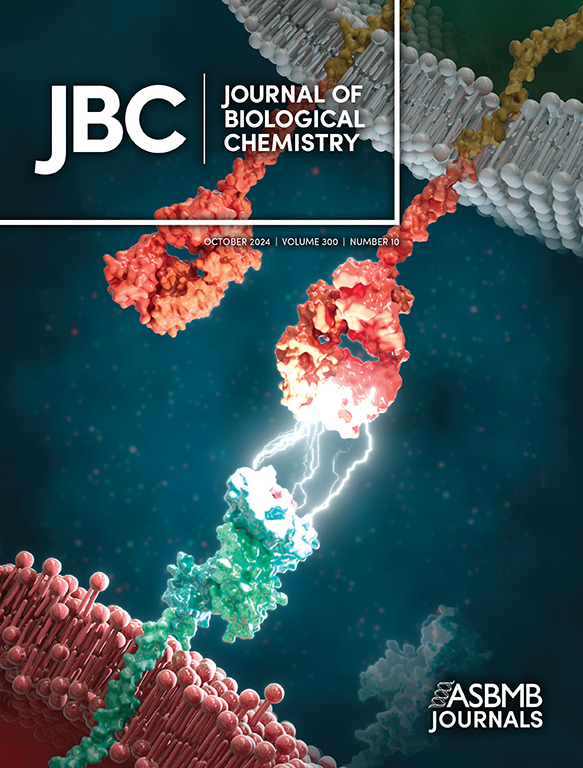Molecular determinants of nucleic acid recognition by an RNA-targeting ADP-ribosyltransferase toxin.
IF 4
2区 生物学
Q2 BIOCHEMISTRY & MOLECULAR BIOLOGY
引用次数: 0
Abstract
ADP-ribosyltransferases use NAD+ to catalyze ADP-ribosylation reactions that regulate diverse cellular pathways in eukaryotes or function as toxins delivered by bacteria to kill competitor or host cells. Although most characterized ARTs target proteins, we recently identified RhsP2 as an antibacterial ART toxin that modifies the 2'-OH groups of structured RNAs during bacterial competition. However, the molecular basis for RhsP2's unique specificity toward RNA remains poorly understood. Here, we show that RhsP2 is a divergent member of the ART superfamily that recognizes nucleic acid substrates via a positively charged RNA-binding surface adjacent to its catalytic site. Mutations within this surface disrupt both RNA binding and ADP-ribosylation activity, abolishing RhsP2's antibacterial function. We further demonstrate that RhsP2 binds distinct small regulatory RNAs with varying affinities, suggesting that both electrostatic interactions and shape complementarity contribute to RNA target selection. Together, our findings define the molecular determinants of nucleic acid recognition by an unusual RNA-targeting ART toxin.rna靶向adp -核糖基转移酶毒素识别核酸的分子决定因素。
adp -核糖基转移酶利用NAD+催化adp -核糖基化反应,在真核生物中调节多种细胞途径,或作为细菌传递的毒素杀死竞争对手或宿主细胞。虽然大多数特征的ART靶蛋白,但我们最近发现RhsP2是一种抗菌ART毒素,它在细菌竞争过程中修饰结构化rna的2'-OH基团。然而,RhsP2对RNA的独特特异性的分子基础仍然知之甚少。在这里,我们发现RhsP2是ART超家族的发散成员,它通过靠近其催化位点的带正电的rna结合表面识别核酸底物。该表面的突变破坏了RNA结合和adp核糖基化活性,从而取消了RhsP2的抗菌功能。我们进一步证明,RhsP2以不同的亲和力结合不同的小调控RNA,这表明静电相互作用和形状互补都有助于RNA靶标选择。总之,我们的发现通过一种不寻常的靶向rna的ART毒素定义了核酸识别的分子决定因素。
本文章由计算机程序翻译,如有差异,请以英文原文为准。
求助全文
约1分钟内获得全文
求助全文
来源期刊

Journal of Biological Chemistry
Biochemistry, Genetics and Molecular Biology-Biochemistry
自引率
4.20%
发文量
1233
期刊介绍:
The Journal of Biological Chemistry welcomes high-quality science that seeks to elucidate the molecular and cellular basis of biological processes. Papers published in JBC can therefore fall under the umbrellas of not only biological chemistry, chemical biology, or biochemistry, but also allied disciplines such as biophysics, systems biology, RNA biology, immunology, microbiology, neurobiology, epigenetics, computational biology, ’omics, and many more. The outcome of our focus on papers that contribute novel and important mechanistic insights, rather than on a particular topic area, is that JBC is truly a melting pot for scientists across disciplines. In addition, JBC welcomes papers that describe methods that will help scientists push their biochemical inquiries forward and resources that will be of use to the research community.
 求助内容:
求助内容: 应助结果提醒方式:
应助结果提醒方式:


